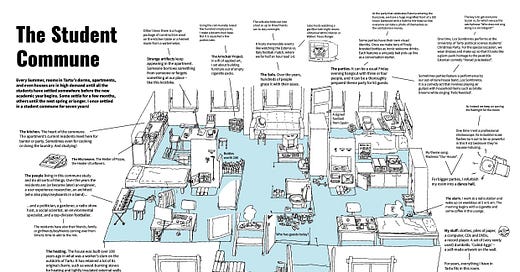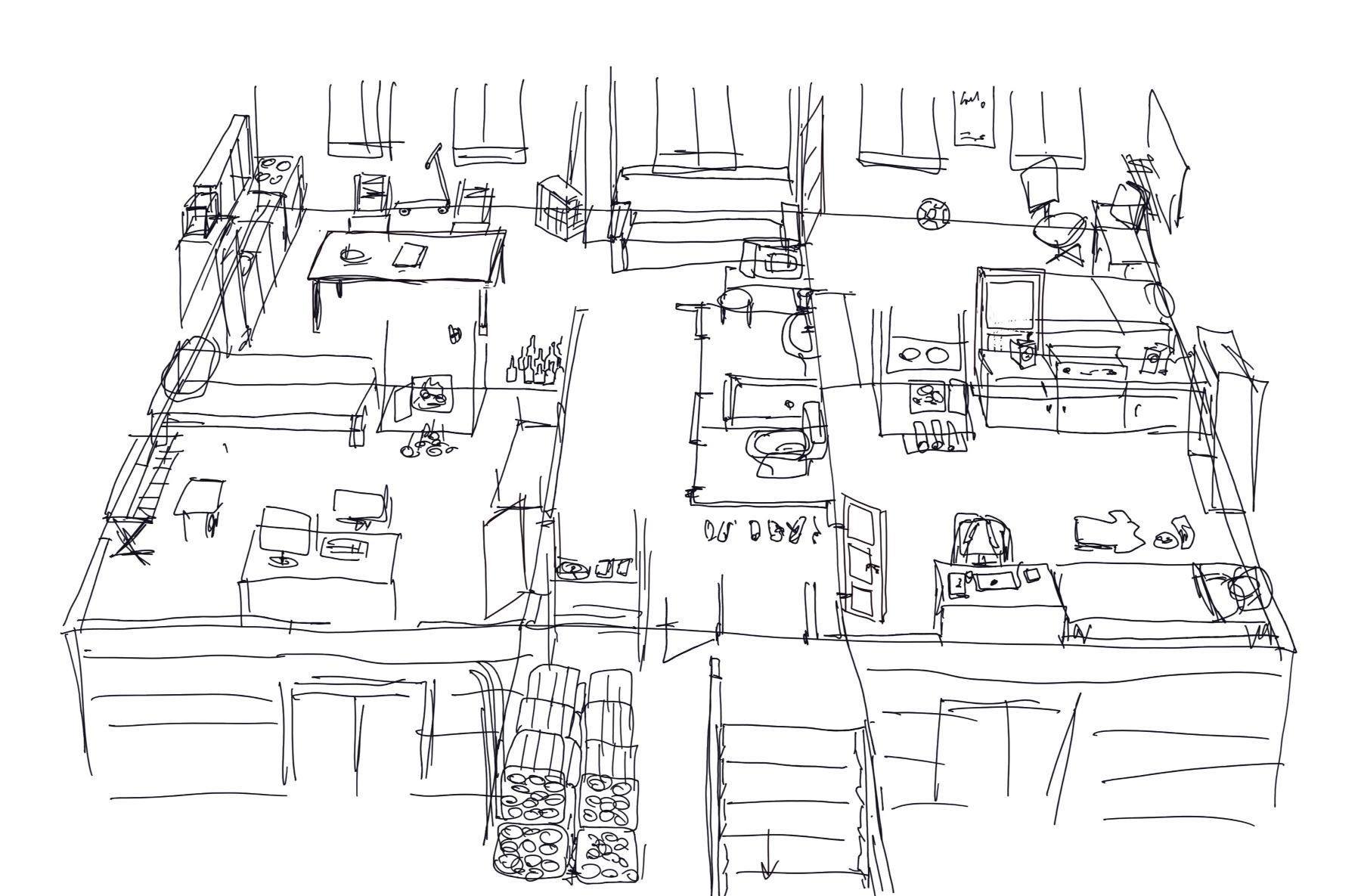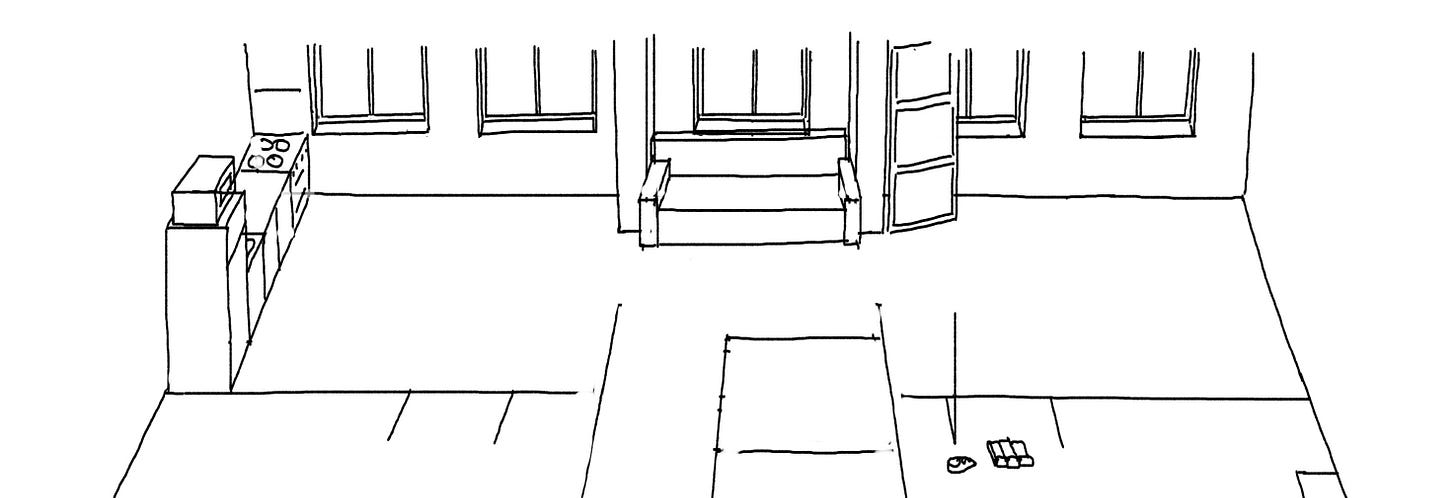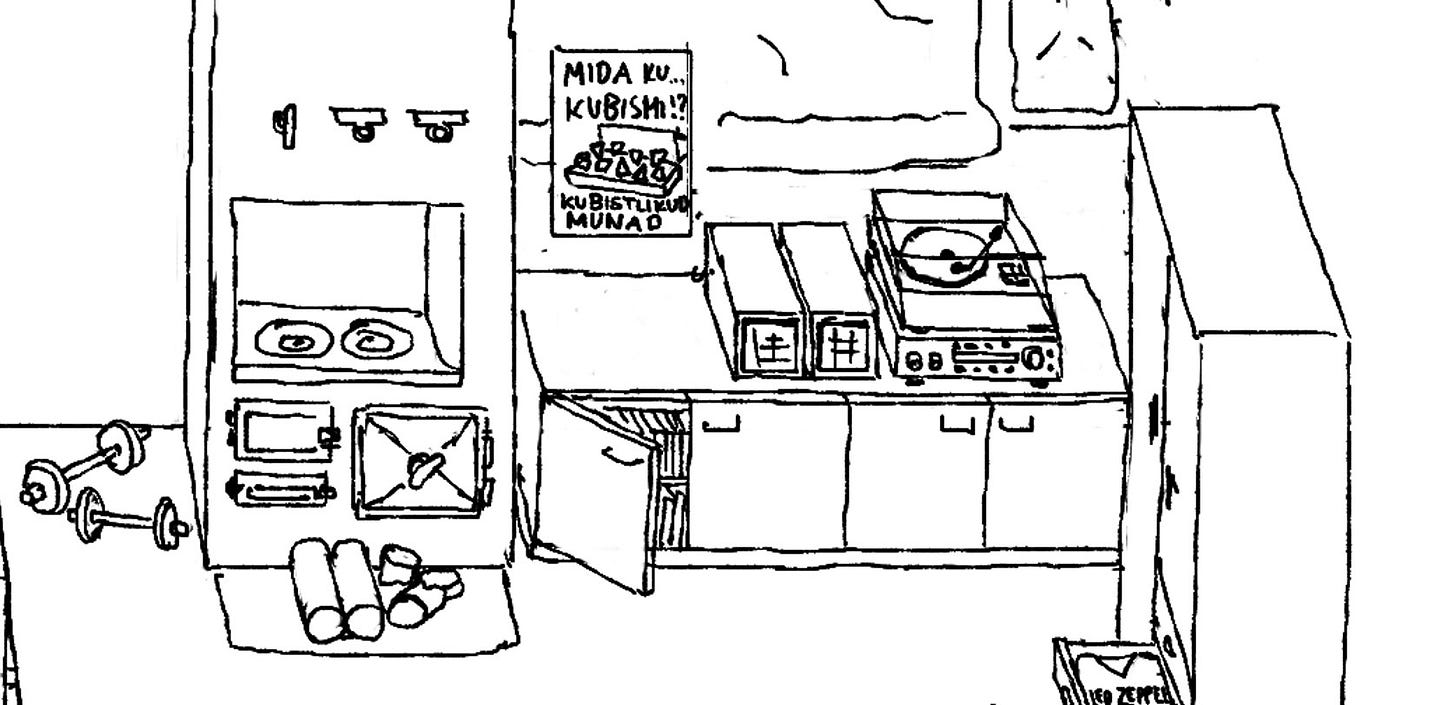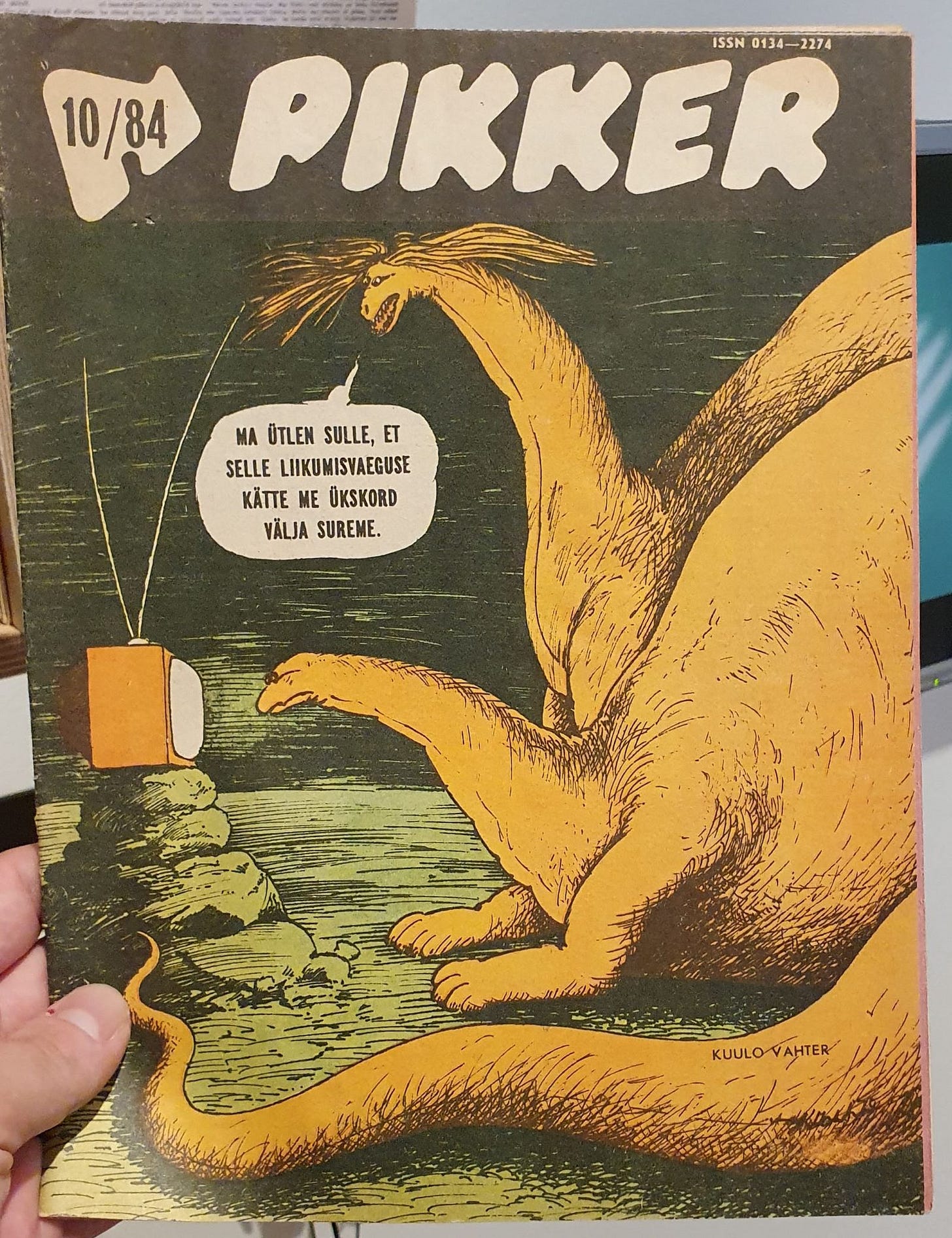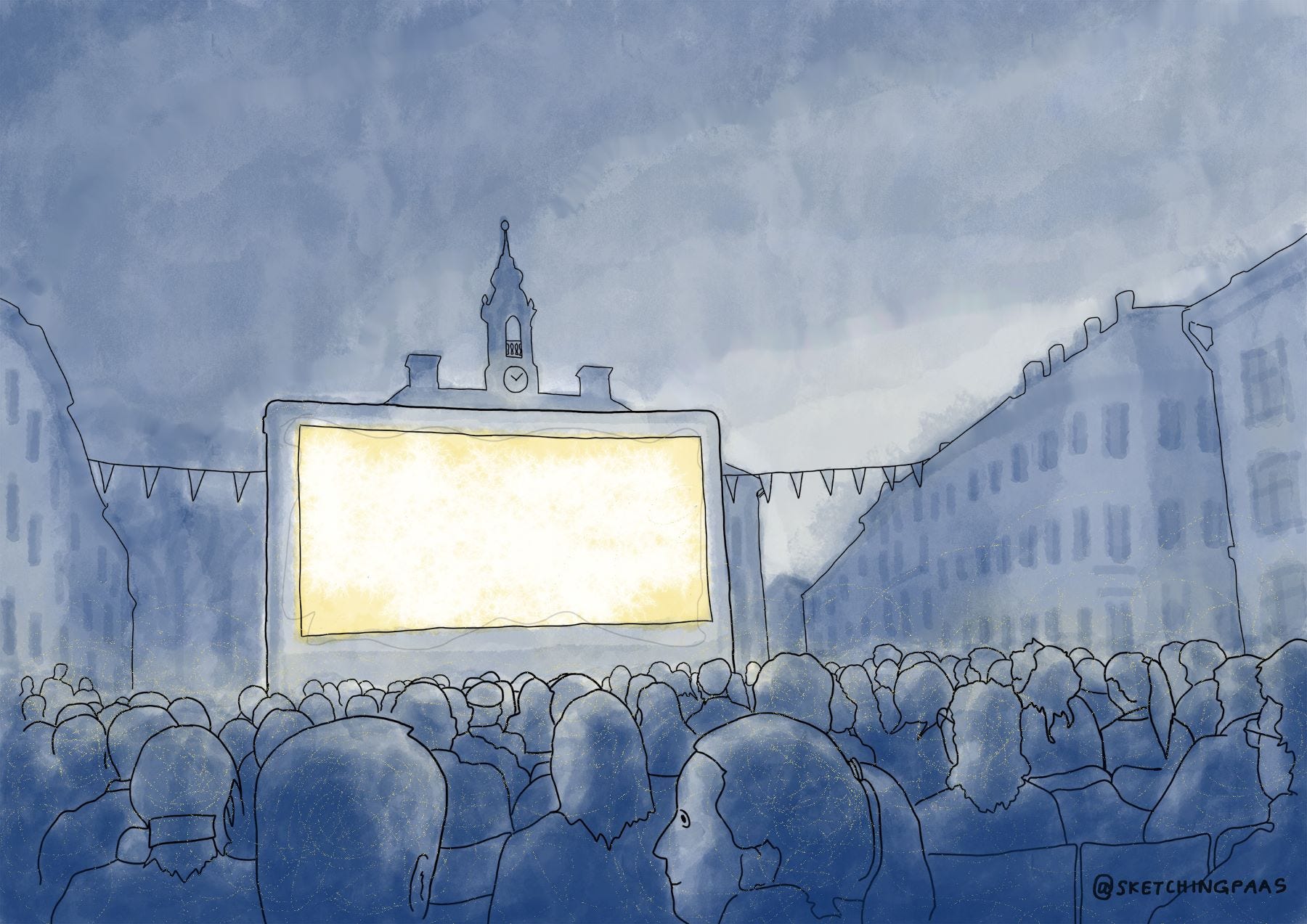The Tartu Observer / August 2024
In this issue: seven years in a Tartu student commune. From a Tartmus exhibition to a 1990s Estonian village. Culture recommendations – what to do in August?
↓ In this issue
1 / Sketchy Stuff: Seven Years in a Tartu Student Commune
2 / Editors’ Observations: In the Art Hall with Childhood
3 / Linguistically Accessible Culture Recommendations for August
1 /
Sketchy Stuff
Seven Years in a Tartu Student Commune
by
Since I started as @sketchingpaas, I've made a few lists of the things from Tartu that I'd like to draw and write about. I'm very happy to share with you a new sketchingpaas artwork that was on each of those "wish lists": "The Student Commune" (click to view full size).
So how did it finally happen? I made the first sketch for ‘The Student Commune’ a year ago in an early morning burst of creativity and it took me maybe only 10 minutes. I'm usually a slow drawer and even slower when it comes to drawing the actual work. So 10 minutes was turbo-fast.
I would revisit this quick sketch every few months to figure out how to actually draw it. When it comes to man-made spaces, I tend to go for realistic, straight lines. This time, however, it didn't feel right.
In between, I wrote down most of the text for the artwork, and only then did I realise that the atmosphere I was trying to recreate didn't match with ruler-drawn straight lines. This is not a straight-line story! It needs to be looser, wavier, and a bit out of scale.
Also, it's not a story for the rigid, uniform digital brush that I usually use. Instead, I chose a more realistic brush that leaves a slightly varying line. Looking back, I think those two decisions about how I wanted to draw it laid the foundation for this work for me.
I drew the first sketch completely from my head, as I wanted to use it as a kind of memory test. How do I remember this place? What do I remember? Only when I had figured out how to draw the final work did I start looking through photo albums for references for drawing key objects.
Although it took a big effort – as have all the ‘How to Tartu’ works –, creating ‘The Student Commune’ was also a lot of fun. I really like the finished work. I hope you enjoy it too!
By the way, I see this work as half of an entity, as there should be another piece that observes student life in Tartu in the late 1980s, when my parents studied in the same city, just a few quarters away from where ‘The Student Commune’ takes place.
→ If you want another view of what Tartu was, is, and wants to be, find another work of mine, ‘The Bridges of Tartu’ set of storytelling postcards at Rahva Raamat online store or at Tasku Rahva Raamat!
2 /
Editor’s Observations
In the Art Hall with Childhood
by
Last week I visited an exhibition in Tartmus, the Tartu Art Museum, twice.
I had to move at a pace of half an exhibition a day, as our 9-month-old daughter didn't find it as fascinating as I did. But after having some rest, we returned the next day and finished watching it.
The exhibition ‘Initiative from Below. Estonian Caricatures in the 1980s’ dealt (mainly) with Estonian caricatures in the 1980s. It was a decade that began with the ongoing heavy Soviet censorship of art and media in occupied Estonia, but ended with the Singing Revolution and already a relatively free press.
I wanted to see the exhibition first because of Pikker, a now-defunct but once extremely popular satirical and humor magazine that in the 1980s had to bash capitalism, (free) Western Europe, and anything related to the United States.
At the local level, Pikker's satirical articles and drawings might poke fun at some everyday communal issues, lightweight marital problems, drunkards, incompetent middle managers, or the lack of certain goods, but they were not allowed to delve into politics and top management.
According to the then editor-in-chief, each issue of Pikker had to go through three (!) stages of censorship, the last of which was in Moscow, before it was made available to Estonian readers.
Of course, this did not stop some illustrators and authors from trying to pack hidden meanings into their works, and it did not stop tens of thousands of readers from trying to discover them between the lines.
I was also an avid reader – or rather, a viewer – of Pikker. Only a little later, in the mid-1990s. When I was growing up in Lepna, a former kolkhoz centre that was slowly trying to figure out what kind of village it could be in free Estonia. We were far from having new magazines and books everywhere. But we had some, and we had stacks of old stuff.
I would often sit on the old metal spring bed in my grandfather's smoky summer chambers and rummage through dusty Pikkers. Although they were only 10 to 15 years old at the time - as if they were from 2009 or 2014 in today's timeline - they felt much older. The changes in society had been rapid and profound.
I wasn't so interested in the written humor, but I really liked Pikker's caricatures and cartoons. Not the messages in support of the criminal Soviet regime, but - when I think back - the conceptual quality, smartness of many of the illustrations, the quality of the compositions, drawings, and coloring.
I think that what I see in Pikker is technically high-quality works of art that can teach and inspire the same craft today.
In fact, I tend to believe that in the decades that followed, the amount, variety, or quality of such illustrations in Estonian media decreased greatly.
Why? Firstly, the role of humour in society changed greatly after regaining independence. Now that everyone could speak freely, the anticipation and excitement of reading the subtleties between the (drawn) lines was lost.
I also feel that globalization has also made humor much more global, and more diverse and fragmented. Everyone can choose their own (often English-speaking) subgenre of humour. Rarely do we all meet in the middle to laugh at the same thing.
Finally, enormous advances in digital photography and, more recently, image-generating artificial intelligence have marginalised the laborious art of illustrating something with hand-drawn caricatures and cartoons. Especially in Estonian. (Although making anything in Estonian has always been relatively expensive and rare art, as the audiences are small.)
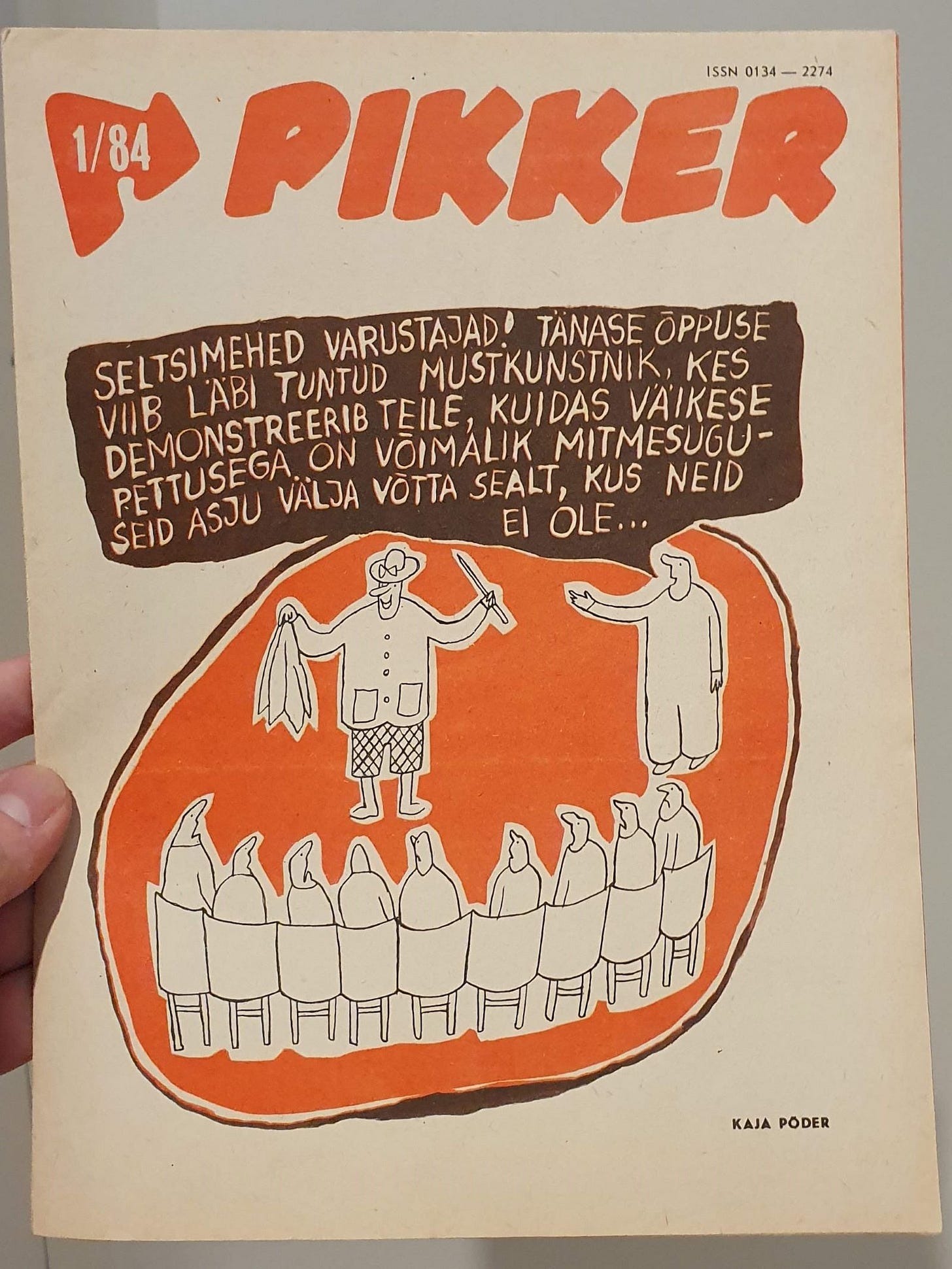
Wondering about these funny things, I browsed the old magazines with my daughter.
The Pikkers in my childhood undoubtedly influenced me in ways that are still visible today. Maybe they're one of the reasons I draw. And maybe that’s why I have a soft spot for communal humor. And maybe this has also been reflected in my life in Tartu, in the years I spent in the student commune.
→ Although ‘‘Initiative from Below. Estonian Caricatures in the 1980s’’ has come to an end, keep an eye on Tartmus as an international contemporary art exhibition for children, ‘The Secrets of the Leaning Building’, will open on August 9.
3 /
Culture Recommendations for August
Linguistically Accessible Events
by
Tartuff
I moved to Tartu in 2006 and that was also when the first Tartu Armastusfilmide Festival (Tartu Love Film Festival) Tartuff took place on Raekoja plats. The festival became popular very quickly, like the Kissing Students sculpture, and now feels like a really deep-rooted Tartu tradition. In fact, if you've lived in Tartu long enough, you've been to a number of Tartuff screenings with your friends, family, and life partners. Or alone.
Every year, some of the films you see under the warm and dark August night sky really leave an impression. My absolute favorite is definitely ‘Le voyage dans la lune’, Georges Méliès' incredible visionary work from 1902, restored and set to a soundtrack by the contemporary band Air. But I also remember the apocalyptic visions of ‘Melancholy’, the sweet melancholy of ‘Les Parapluies de Cherbourg’ and the sensual expeditions of ‘Emmanuelle’. And also some comedies. What will you remember? You have to see it for yourself, from August 5 to 9, at Raekoja plats.
Jazz concert on the edge of the biggest bog system
Last winter, I accompanied a group of Austrian journalists on a deep snow hike at the beginning of Emajõe-Suursoo, the biggest bog system in Estonia. Our hike began and ended at Emajõe-Suursoo Keskus, a cozy yet tastefully modern nature centre built on top of a historical tavern site. It is a special place on the edge of the Emajõgi delta, one of the least populated areas in Estonia, but only 25 kilometres to the east of the Tartu city centre!
On Friday, August 9, the centre hosts the concert of Tõnu Naissoo, a very respected Estonian jazz pianist. The event is promoted to be a mix of ‘pastel piano sounds and nature on the edge of the world’. Sounds promising!
Simple Session 24
In the summer of 2000 in Tähtvere, in a newly opened skatepark by Tartu laululava, a BMX and skateboarding event took place. No one knew that in a few years, the event would move to Tallinn and become one of the biggest extreme sports festivals in Europe, attracting tens of thousands of spectators and millions of online viewers.
Simple Session, as it is known nowadays, has taken place also in Helsinki (FI) and Riga (LV), but only the European Capital of Culture year brings it back to its roots. From 21-23 August, a hundred of the world’s most skilled BMX riders and skateboarders compete in Kammivabrik in Karlova, to the beat of a four-day party and concert programme.
→ See Tartu and Southern Estonian events at kultuuriaken.tartu.ee and Tartu2024.ee. The latter has also a handy list of top events.
See you in Issue #6!
The Tartu Observer is written and drawn by @sketchingpaas. If you feel this issue was well worth your time, consider buying a print from me, becoming a paid subscriber, or buy me a drink.


